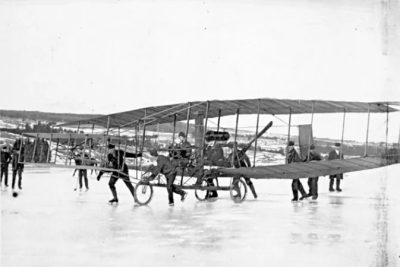
Photo courtesy of the Canada Aviation and Space Museum
Today (Friday, February 23) marks the 115th anniversary of the first powered heavier-than-air flight in Canada. It took place near Baddeck Bay, Nova Scotia in 1909. The aircraft was the Silver Dart, whose project leader was none other than local resident and prolific inventor Alexander Graham Bell. Engineer J.A. Douglas McCurdy was at the aircraft’s controls.
The Scottish immigrant had already established a name for himself, largely in the United States, by working on the development of the telephone and registering the first U.S. patent of it in 1876. Much of his initial work was done years earlier at his parents’ home near Brantford, Ontario.
But it was years later, after having co-founded the American Telephone and Telegraph Company (AT&T), that he began working on one of his other passions – aeronautics. At the time, Bell had a summer home in Baddeck, Nova Scotia and began spending more and more time there in the early 1900s. It was at the age of 62 that Bell and his team accomplished the first powered airplane flight anywhere in the British Empire, with Canadian engineer John McCurdy at the controls. Also on the team was American Glenn Curtiss, who supplied the 50-hp V-8 engine that powered the canard-winged Dart.
Bell, often claimed to have been a Canadian citizen, was born as and continued to be a British subject even when he was resident of Canada – Canadian citizenship for British subjects was a loosely defined concept at that time. However, Bell was naturalized as an American citizen in 1882 and spent many years living in that country, marrying a Mabel Hubbard, a deaf U.S. citizen and bearing two daughters.
Bell died in Baddeck, N.S. in 1922 at the age of 75.
